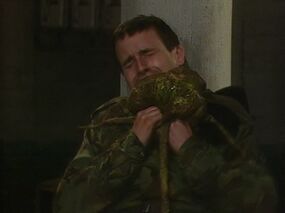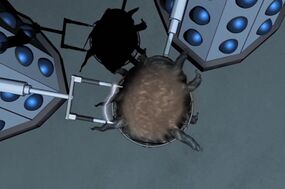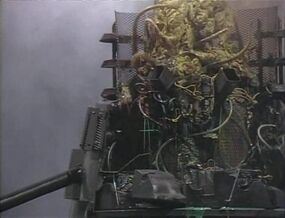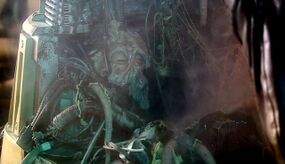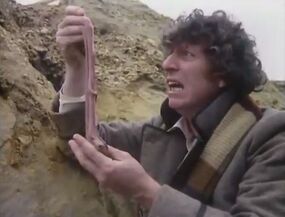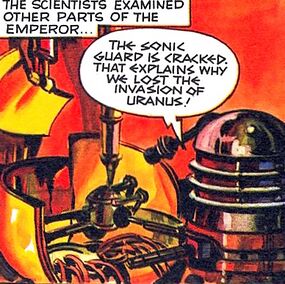Dalek mutant: Difference between revisions
ZiyiCrafting (talk | contribs) m (Removed redundant word) |
Aledownload (talk | contribs) |
||
| Line 11: | Line 11: | ||
== Biology == | == Biology == | ||
[[File:DM.jpg|thumb|A Kaled | [[File:DM.jpg|thumb|A Kaled mutant attacks a soldier ([[TV]]: ''[[Resurrection of the Daleks]]'').]] | ||
Kaled mutants had a fundamental [[DNA]] type of 467-989. ([[TV]]: ''[[Daleks in Manhattan]]'') They were [[cephalopod|cephalopods]], being large brained creatures with [[tentacle]]s, though young mutants were globular, soft and shapeless with tendrils. Although usually dependent on their travel machines for offence/defence, the bare mutant could be dangerous; even the young were quite lethal and capable of strangulation with their tentacles, and, in this way, attacked the [[Fourth Doctor|fourth]] and [[Seventh Doctor|seventh incarnations]] of the [[Doctor]]. ([[TV]]: ''[[Genesis of the Daleks]]'', ''[[Remembrance of the Daleks (TV story)|Remembrance of the Daleks]]'') The [[Fifth Doctor]] once said that they had a deadly sting, and during a [[1984]] incursion into [[London]], one of these creatures, separated from its casing, attacked and injured a [[human]] soldier without difficulty. ([[TV]]: ''[[Resurrection of the Daleks]]'') | Kaled mutants had a fundamental [[DNA]] type of 467-989. ([[TV]]: ''[[Daleks in Manhattan]]'') They were [[cephalopod|cephalopods]], being large brained creatures with [[tentacle]]s, though young mutants were globular, soft and shapeless with tendrils. Although usually dependent on their travel machines for offence/defence, the bare mutant could be dangerous; even the young were quite lethal and capable of strangulation with their tentacles, and, in this way, attacked the [[Fourth Doctor|fourth]] and [[Seventh Doctor|seventh incarnations]] of the [[Doctor]]. ([[TV]]: ''[[Genesis of the Daleks]]'', ''[[Remembrance of the Daleks (TV story)|Remembrance of the Daleks]]'') The [[Fifth Doctor]] once said that they had a deadly sting, and during a [[1984]] incursion into [[London]], one of these creatures, separated from its casing, attacked and injured a [[human]] soldier without difficulty. ([[TV]]: ''[[Resurrection of the Daleks]]'') | ||
Revision as of 09:09, 11 June 2018
Kaled mutants were the mutated descendants of the humanoid Kaleds on the planet Skaro. Enclosed in protective armour and weaponry, they became the organic parts of the Daleks, mounted in the upper parts of the Dalek travel machines. The Third Doctor once described the Kaled mutant to Sarah Jane Smith as "a living, blubbling lump of hate". (TV: Death to the Daleks)
Biology
Kaled mutants had a fundamental DNA type of 467-989. (TV: Daleks in Manhattan) They were cephalopods, being large brained creatures with tentacles, though young mutants were globular, soft and shapeless with tendrils. Although usually dependent on their travel machines for offence/defence, the bare mutant could be dangerous; even the young were quite lethal and capable of strangulation with their tentacles, and, in this way, attacked the fourth and seventh incarnations of the Doctor. (TV: Genesis of the Daleks, Remembrance of the Daleks) The Fifth Doctor once said that they had a deadly sting, and during a 1984 incursion into London, one of these creatures, separated from its casing, attacked and injured a human soldier without difficulty. (TV: Resurrection of the Daleks)
One Dalek remained operational for four thousand centuries. (AUDIO: The Lights of Skaro)
The mutants on occasion demonstrated an accelerated healing ability in response to localised wounds. One Dalek mutant in particular, while being tortured by Commander Farrow, began to repair its damaged body, its flesh growing over Farrow's hand and burning it. (AUDIO: Jubilee)
The voice of a Dalek was electronic as the actual vocalisations from the mutants amount to little more than squeaking sounds. Without the assistance of their casing, they were unable to produce speech as they did not possess tongues or vocal chords. (TV: Resurrection of the Daleks, AUDIO: Jubilee)
Kaled mutants were quite possibly fatal to a Time Lord when eaten. (PROSE: The Scarlet Empress) However, their "Dalek juice" could be ingested with no apparent ill-effect. (AUDIO: Jubilee)
The Eleventh Doctor claimed that "[t]here [wasn't] a bone in [a Dalek's] body." (TV: Victory of the Daleks)
Variations
Kaled mutants often varied in appearance, as the Daleks continuously altered their DNA, (TV: Victory of the Daleks) though kept the same basic structure of a relatively-octopoid species with a comparatively large brain. Because the mutants were genetically designed to "not die," as they aged they would degenerate and liquefy. (TV: The Witch's Familiar)
Davros's original mutants were yellowish-green globs with tendrils able to lash out and choke someone. (TV: Genesis of the Daleks) Thousands of years later, there were mutants in the Skarosian wilds. These appeared as gurgling pink blobs that could stretch and be handled, but had no apparent tentacles, brain, or eyes. Whatever reason they were not in Dalek casings is unknown. (TV: Destiny of the Daleks)
Other mutant variations included one that possessed a clawed "hand", during a time when the Thals believed the Daleks' mutation had not come "full-circle" and that they had not reached their final form. (TV: The Daleks) Other mutations were green blobs with tendrils that were "scooped" into their casings. (TV: The Power of the Daleks, The Evil of the Daleks)
During the Imperial-Renegade Dalek Civil War, the mutants were eyeless and green with whip-like tentacles. (TV: The Five Doctors, Resurrection of the Daleks) The Imperial Daleks commanded by Davros were surgically altered, with their appendages physically grafted into their machines, which the Renegade Daleks saw as impure. (TV: Remembrance of the Daleks)
Others, after the Last Great Time War, were pale-pink, blue-green or green-brown with one large functioning eyeball and a small vestigial socket. The remnants of a face could be seen, more clearly on some mutants than on others; as well as the functioning eye and the sealed-up eye, a nose and mouth were vaguely discernible. (TV: Dalek, The Parting of the Ways) The mutants created using human cells produced small, blue-green creatures, apparently consisting purely of a head, with two eyes and an overall clearer "face". (TV: The Parting of the Ways)
Dalek Sec had lower tentacles that were long enough to grab hold of an adult human and had an unusual, trunk-like appendage that could envelop and carry a whole adult human. (TV: Daleks in Manhattan)
Mutants of the New Dalek Empire were grown by the cells of Davros' own body, (TV: The Stolen Earth) meaning they were not "pure" Daleks. Survivors of the encounter with the Doctor, using a progenitor, tricked the Eleventh Doctor into helping create a New Dalek Paradigm, possessing pure DNA but still maintaining the appearance of other post-Time War mutants. (TV: Victory of the Daleks, Asylum of the Daleks, Into the Dalek COMIC: The Only Good Dalek, GAME: City of the Daleks, The Doctor and the Dalek)
History
For an account of the creation of the Daleks, see separate article.
Info from Twice Upon a Time needs to be added
Kaled mutants appeared different over time, and, as noted above, during the war between the Imperial and Renegade Dalek factions, the two sides had physical differences, with Davros' side now altered into true cyborgs and physically made one with their travel machines, (TV: Remembrance of the Daleks) whereas they had only used the casings as battle armour and were not actually integrated into them. (AUDIO: The Four Doctors)
Iris Wildthyme once became fatally ill after eating a live Kaled mutant. (PROSE: The Scarlet Empress).
By the time several Dalek variants from across history had returned to Skaro to make it anew, the Dalek City possessed "living" sewers where the walls were made of decaying, liquefying, enraged mutants that would attack other Daleks if they could. (TV: The Witch's Familiar)
Behind the scenes
- In the first TV appearance of the Daleks in The Daleks a single clawed hand of the mutant was revealed. The comic The Dalek Chronicles and other media revealed many "facts" about the Daleks which did not appear on television. Nevertheless, the full appearance of the inner creatures remained undisclosed until The Power of the Daleks on television, in the form of newly created creatures. They appeared in their adult form in The Evil of the Daleks. Both appeared as eyeless shapeless creatures with tendrils.
- They first appeared in colour in Genesis of the Daleks (as young) and as adults in Destiny of the Daleks. In the latter story, the Fourth Doctor makes statements which imply that the Daleks have now abandoned any organic component and have turned themselves into robots. Future stories did not explain and elaborate and returned to the previous concept of the Daleks as ultimately organic. The Five Doctors showed much of the adult Kaled mutant for the first time.
- From Series 1 onwards, the Kaled mutants went through a major re-design. They now had a single eye, more defined bodies and 11 ropy tentacles, though the mutant seen in City of the Daleks had 12 tentacles instead of the usual 11.
